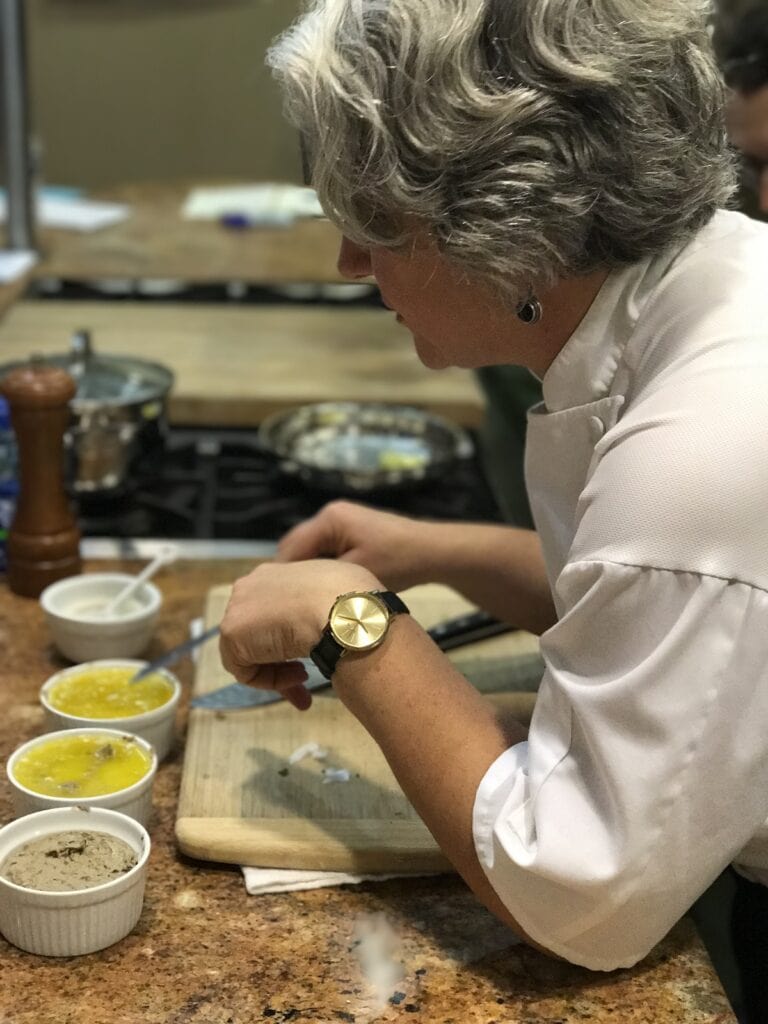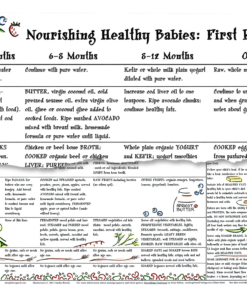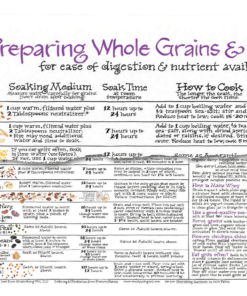Liver is known as “king of the organs” for the multitude of functions it performs in the body. According to Johns Hopkins, this organ performs 500 vital functions, from producing bile and all-important cholesterol to converting excess glucose into glycogen and so much more. Liver is also a superfood. In fact, it is the most nutrient dense food on the planet, something that many of our mothers and grandmothers understood as a matter of course. For them, liver with bacon and onions was featured on the dinner menu once a week. And as their children walked out the door to face another day among the masses (aka school), they were given their daily dose of cod liver oil. (Learn more about cod liver oil in my blog post “The Importance of Fermentation.”)
Liver earns its title as the most nutrient dense food because it is a concentrated source of fat-soluble vitamins A, D, and K, and just a little yields a lot. For our bodies to use the fat-soluble vitamins in liver, we need to eat it with fat, the best or which is animal fats. When making beef liver, I recommend adding bacon or lard (pork fat). The reason for this is that the high levels of vitamin D in pork fat balances the high levels of vitamin A in beef liver. When eating liver from other animals and poultry, you can use any other healthy fat with balanced levels of A, D and K (such as duck or chicken fat, tallow, ghee, or butter).
Liver is commonly sautéed with fat and onions, or made into a paté. I love paté because fat is combined with liver in every bite. When it is made well, paté can be every bit as creamy as ice cream—and just as delicious. I have seen whole classes of students licking their plates clean after making their paté.
Read on to learn how to prepare liver prior to cooking it. You will also find easy, delicious recipes that will impress everyone. I will break down the cooking techniques by stages for those on the Gut and Psychology Syndrome (GAPS) Intro diet.
Bon appetit!
What is liver paté? I came up with a little rhyme to help people remember what a paté is: “A paté is a sauté that you puree with extra grasse” (fat). To put it simply, all you need to do is sauté liver in some healthy fat, then puree it with extra fat—that’s paté! Here are some general guidelines:
Soaking liver prior to cooking: It should go without saying that the best liver is derived from pastured animals. These animals are fed a clean, nutritious diet, free from GMOs in soy or corn feed and glyphosate. (After all, you are what you eat eats).
If you are making liver from beef, pork, lamb, or any other mammal, soak it in an acidic medium for several hours to help mellow the flavor and remove impurities. This can include vinegar, whey, yogurt, raw milk (not pasteurized), or lemon juice. (However, soaking raw liver in lemon juice can “cook” it, so a shorter soak of two to three hours is best.) Next, simply rinse and pat the liver dry before you cook it. When preparing liver for paté, there is no need to remove the outer membrane. It will be pulverized later in the food processor.
You do not need to soak liver from chicken and other poultry. Simply rinse and remove the veins with a sharp knife before cooking.
Best fats for sautéing liver: These include duck fat, chicken fat, bacon fat, lard, tallow, ghee or pastured butter. Keep in mind that chicken or duck fat is delicious with poultry liver; lard with beef liver; tallow with lamb liver, and so on.
In my experience, the fat that guarantees the creamiest paté is cultured cream (aka crème fraiche). If you cannot tolerate cultured cream, then pastured butter is also good.
Paté accoutrements: These often include vegetables, herbs, spices, and wine, cognac, or brandy. For the GAPS Intro diet, you may use apple cider vinegar or stock in place of wine, cognac, or brandy. For the Full GAPS diet, you may use dry red or white wine.
Paté for the Intro diet, Stages 1–3: For the earlier stages of the Intro diet, you will cook the liver, onions, and garlic in stock instead of sautéing them in fat. Next, they are pureed with a fat such as pastured butter, crème fraiche, or homemade GAPS sour cream. Fresh herbs can be added while cooking the stock or tossed right into the food processor. See the recipe for GAPS-Style Chicken Liver Paté I below for details.
Paté for the Intro diet, Stages 4–6 and Full GAPS: Once you begin Stage 4, the livers can be sautéed in fat rather than cooked in stock. And as I noted above, duck or chicken fat works well with chicken and other poultry livers. Similarly, lard is delicious with beef livers, tallow with lamb liver, and so on. See the recipe for GAPS-Style Chicken Liver Paté II below for details.
Paté for those not on GAPS: If you are not on GAPS but would still like to add this superfood to your diet, I suggest using the recipe for Chicken Liver Paté II below. This is more of a “typical” paté recipe.
GAPS-Style Chicken Liver Paté (Stages 1–3)
In this recipe, the liver is cooked in stock instead of sauteed in fat like a typical paté. Appropriate for the GAPS Intro diet Stages 1–3.
Ingredients
½ cup chicken stock
1 lb. chicken livers
1 small or medium onion, 1 bunch of green onions, or 1–2 leeks, minced
2 cloves garlic, peeled and minced
1 tablespoon fresh herbs such as thyme, rosemary, sage, or a combination, chopped
Sea salt to taste
Fresh ground pepper (Stages 2–3 only) to taste
¼ cup (½ stick) pastured butter, softened; alternatively, you may use an equivalent amount (or to taste) crème fraiche (cultured cream), yogurt, or kefir cheese (made from straining yogurt or kefir for whey)
2–3 tablespoons additional pastured butter, melted
Instructions
- Place chicken stock in a saucepan. Add livers, onions, garlic, and herbs. Bring to a boil, then immediately reduce heat to a simmer and cook for about 5 minutes.
- Take pan off heat. Remove liver and set aside to cool. Strain out stock and reserve for later use (such as a drink or to make soup, etc.).
- Place the cooled, cooked liver, onion mixture, softened butter or other fat of choice, salt and (for Stages 2–3 only) pepper in a food processor and puree until smooth.
- Transfer to a ramekin or crock, smoothing off the top with a knife or spatula. Seal the top of the paté with the additional 2–3 tablespoons melted butter.
- Place in refrigerator for several hours to allow butter to harden. Chill well. (Alternatively, eat right away!)
GAPS-Style Chicken Liver Paté II: Stages 4–6 through Full GAPS
In this recipe, the liver is sauteed in a fat. Appropriate for the GAPS Intro diet Stages 4–6 and all the way through the Full GAPS diet.
Ingredients
3 tablespoons pastured butter, ghee, chicken, or duck fat
1 small or medium onion, 1 bunch of green onions, or 1–2 leeks, minced
2 cloves garlic, peeled and minced
1 tablespoon fresh herbs such as thyme, rosemary, sage, or a combination, chopped
1 lb. chicken livers
⅓ cup chicken stock, or a combination of stock and 1–2 tablespoons apple cider vinegar (for Full GAPS, you may use dry white or red wine)
Sea salt to taste
Fresh ground pepper to taste
¼ cup (½ stick) pastured butter, softened; alternatively, you may use an equivalent amount (or to taste) crème fraiche (cultured cream), yogurt, or kefir cheese
2–3 tablespoons additional pastured butter, melted
Instructions
- Melt fat in heavy skillet or sauté pan.
- Sauté onions until translucent, about 10 minutes. Add garlic, herbs, and livers. Stirring frequently, cook over medium heat until livers are cooked on the outside (with no blood showing) and pink inside, about 5–7 minutes. Do not overcook.
- Add stock, or stock/vinegar combination, or wine, and cook over medium heat, uncovered, until the liquid is gone. Take pan off the burner and allow to cool.
- Place liver mixture, softened butter or other fat of choice, salt, and pepper in a food processor and puree until smooth.
- Transfer to a ramekin or crock, smoothing off the top with a knife or spatula. Seal the top of the paté with the additional 2–3 tablespoons melted the butter.
- Place in the refrigerator for several hours to allow the butter to harden. Chill well. (Alternatively, eat right away!)





